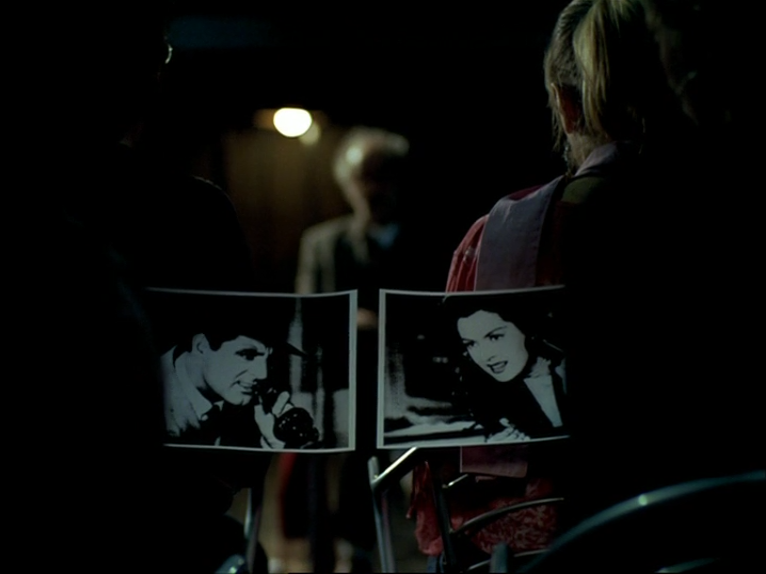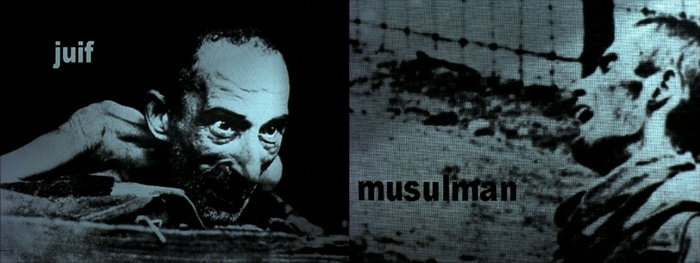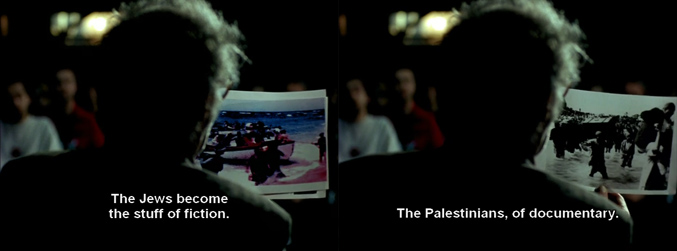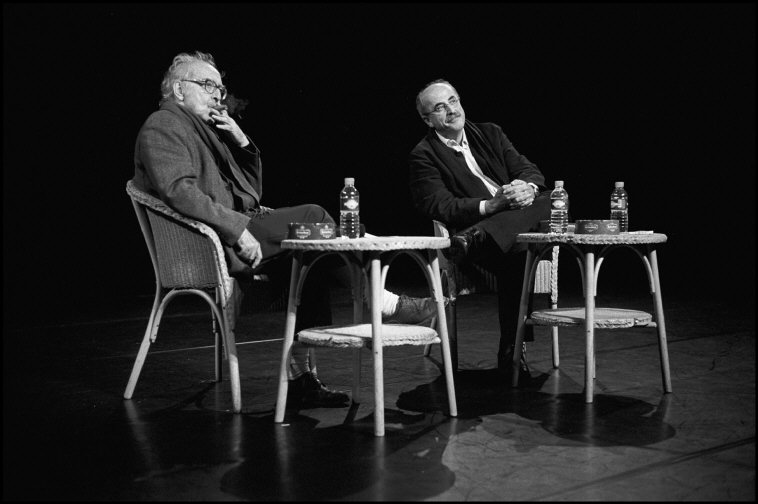
Some rough translations of extracts taken from various texts written by and interviews with Godard, all related to the question of ‘Montage Interdit’ – the main issue of the next DISSENT ! session with Eyal Sivan (12 December).
——————————————————————————————————————————————————————-
Talk with Antoine de Baecque about an interview that Godard attempted with Yasser Arafat, as published in Godard: biographie, Grasset, 2010.
“I asked him if the origins of the Palestinians’ difficulties had something to do with the concentration camps. [Arafat] said to me, ‘No, that’s their story, the Germans and the Jews.’ And I said, ‘Not exactly, you know that in the camps, when a Jewish prisoner was very weak, close to death, they called him Muslim [musulman].’ And he responded, ‘So?’ I said, ‘You know, they could have called them black or an entirely different name, but no, they said Muslim, and that shows that there is a relationship, a direct relationship between the Palestinians’ difficulties and the concentration camps.’”
——————————————————————————————————————————————————————-
Letter to Christa Maerker, March 1995.
“… Understand that I pay attention, if even possible, to what images say as well as to what they withhold; for example, to those millions of Jews, gypsies, all those who struggled, those we “celebrate” these days, forgetting that in the ultimate stage the German language decorated them with the name “musulman”, which leads us to Sarajevo, doesn’t it. “Montage Interdit” – forbidden montage, as Bazin would say.”
——————————————————————————————————————————————————————-
Interview with Youssef Ishaghpour, published in Archéologie Du Cinema Et Mémoire Du Siecle, 2000.
“… It’s a juxtaposition and it’s an image, like many of the ones in Histoire(s). No one but me has said that at one point in the extermination camps the Germans had decided to declare a Jew to be a Musulman. Although they all knew it, the survivors, it’s in all the books, but no one made the juxtaposition, not even when the war broke out in the Middle East… But that’s an image, one day it struck me as an image, that there should be two words juxtaposed, it’s two images…”
——————————————————————————————————————————————————————-
Interview with Serge Kaganski, published in Les Inrocktibles, May 2004.
Notre Musique deals with genocide. What can cinema do in the face of genocide?
I don’t know. I wanted the film to bears the marks of the Israeli–Palestinian conflict, a conflict we feel close to since a long time. Me and Anne-Marie Miéville, we met at the Palestinian library in Paris. As dropouts, driven from our cinematographic domain by what we can call American cinema, I feel close to the Vietnamese, the Palestinians… As creators, we have become outcasts. For a long time I have been saying that I was working in the fringes, but that it’s because of the fringes that the pages come together. Today I have fallen from the fringes, it feels as if I am inbetween the pages.
In you most recent film, the poet Mahmoud Darwish says: “we have the misfortune and good fortune of having Israel as our enemy. You’ve brought us defeat and renown.” Can you comment on that reflection?
It’s true. But we can’t resolve it with phrases, like that. We have to take the time to examine the facts and out of that, perhaps, like in scientific experiments, can come a necessity or utility for a phrase we can use as a precept, to heat up water or send a rocket into space. Before that there is nothing. We can only say: “look”.
The Israeli–Palestinian conflict is very present in the film…
No, not really. I wanted there to be a representative of poetry in the film, and that it’d be Mahmoud Darwish, rather than an Irish poet, for example. I also wanted there to be a conversation, stemming from an old project of dialogues with my intellectual opponents, such as Claude Lanzmann, Bernard-Henri Lévy, Alain Finkielkraut… But Lanzmann didn’t want to be filmed. (1)
You have signed a petition against the cancellation of a screening of Eyal Sivan and Michel Khleifi’s film Route 181 at Centre Pompidou. The film includes a sort of détournement of the barber scene in Shoah…(2)
If you say so. I don’t see why it would be a détournement of Shoah. There are barbers in Palestine, aren’t there? On the ordnance road, there would have only been tanks. Route 181 is a good television film. It’s true that, as you say, it advances meaning, intent. It’s a militant film. There are good ones and lesser ones. In the great barber scene in Shoah, there is no more intent, and then you attain something else.
Do you define the films you’ve made between 1968 and 1972 as militant films?
Some, not all of them. I tried to escape that, I tried to be more militant in cinema, and from there on reach militants in Vietnam, or elsewhere… But I never considered the camera as a gun. Nor did I believe that one had to make cinema with the camera on the shoulder, in the heart of the struggle. Today there are other forms of cinema of intent. For example, I don’t like Chantal Akerman’s films very much, suh as Sud or De L’Autre Côté. The intent is visible. It consists of, let’s say, filming the poor. Before it were the rich people who were noble, today it’s the poor (laughs). And on this noble subject, she applies a so-called formal rigor. She uses travellings, beautiful frames. We can call that a dispositive. Or an installation, like Boltanski, who puts pyjamas in the nave of a church and calls it “deportation” or I don’t know what. Always the name and the intent, the legend and not even the picture.
Do you watch television?
Yes. From time to time, television transmits something. It is supposed to be made for that, so sometimes we see a face, a voice, a document we don’t know and it makes us happy. But it’s mixed in with all the rest. It’s like they say: haven’t there also been some decent people in Soviet Russia? Or in Nazi Germany? Or in today’s United States of America?
Do you mean to say that there are some “decent programmes’ in an otherwise globally bad televisual landscape?
I sometimes watch debate programmes by way of practice, to see if I still have a taste for argument, if I could still end a discussion with three responses. As I don’t speak to people a lot, I watch those instead. But the image I am looking for are the people in the back, what is called the audience, or the citizens. On television, you can see cleary what democracy means: there are citizens, speechless, there are noblemen, or Parliamentarians, or the governement, around the table; and then there is an animator. That is democracy. It’s an image.
The other day, I was watching my friend (Elias) Sanbar (3), who was talking with the Israelian ambassador on LCI (French television news channel). In the corner of the image, you could see a picture of the map of the Gaza strip. The Israeli said they had to leave this strip because there were 1 million of Palestinians and 7000 Israelis. The strip was marked in red, with a part in blue for the Israelis. One should have seen that the 7000 people had 35% of what the 1 million had. So let’s look at that, and then, let’s find out what to say. But the relation with the image was not made. We are afraid of the image. We prefer a flood of words.
Perhaps this relation between the demographic figures and the image of the Gaza territory hasn’t been established during this programme, but it has been mentioned many times in other media. Perhaps the news channel wasn’t as afraid of the image than of repeating a fact that has been largely divulgated.
It was mentioned in words, not in images.
No, Le Monde or Libération have published many pictures and maps of Gaza.
But accompanied with words, while words are not needed. You make an animation with maps of Palestine from 1948 till today, and then you look. You can even do it from 1900 on, with the first Jewish colonies. Then you look.
You speak of Jewish “colonies” in 1900, although there wasn’t an Israeli nor a Palestinian state back then, and Jews had been living on that land for six thousand years.
Absolutely. It so happens that they were called “colonies”. When a word is used, one can’t be surprised that people pick it up again.
(…)
A shot and counter-shot can be two words, two images, it can be an image and a word, but it’s not two times the same thing in the guise of an other. What is called the other is the same, as in the case of the Hutus and the Tutsis, and that’s why they are fighting each other. They are the same and they hate each other. Three-quarters of the people, you and me, hate each other’s guts. If we don’t analyze, we don’t know that what we don’t like in the other, is ourselves. In regards to that, Lacan sometimes set up shots and countershots. We was quite the filmmaker.
An example of a “real” shot / counter-shot in Notre Musique?
There are some that can perhaps be criticized like Sivan has been. When I show a photograph of a deported Jew on which I write “Jew”, and two images after that, I show a photograph of a corpse against a fence and I write “Musulman”. People have told me “But that’s awful, because the history of the Palistinians is not the Holocaust of the Jews.” But when I write “Musulman’, it’s because in Auschwitz Jews were called “Musulman”. And then Hollywood was called the Mekka of cinema.

——————————————————————————————————————————————————————-
Interview with Jacques Mandelbaum and Thomas Sotinel, published in Le Monde, May 2004.
Three Jewish characters is a lot in one movie (Notre Musique).
I’m the fourth. I’m a Jew of the cinema.
You seem to be placing more and more emphasis on the fate of the Jews. Where does that
come from?
It’s been a gradual process, because I’ve had to educate myself on the subject. At my
grandfather’s house – he was a collaborationist – we would listen to speeches by Philippe
Henriot every evening. During the war, my parents were part of the Swiss Red Cross, visiting
refugee camps. But no one ever explained to me what had happened.
Afterwards, bit by bit, I did some reading here and there and finally made some connections. But
basically, I’ve never succeeded in knowing what it really means to be Jewish. The only way for
me to understand it is to tell myself that I’m the same: I want to be with others, and at the same
time not with others. This is a feeling I have myself.
Exactly what do you mean by the parallel you make between Jews and Muslims in the film,
based on the two photos of Nazi death-camp prisoners? Where did you get the photos you
used for that?
The first photo is well known, it’s a picture of a prisoner with bulging eyeballs, which I believe
was taken when the camps were liberated. The other photo, also of a deported person, gives you the
feeling that the end is near. They’re the ones who were so exhausted physically they were nearly
dead, who were called “Musulman” in the camps. I’ve always wondered how it happened that the
Germans called Jews “Musulman.” And then I realized that this was where the Middle East
conflict started. You’re in an apartment, and someone arrives and says, “I have been appointed
by God; I will now occupy this apartment.” I wanted to make a movie about that with Marcel
Ophuls, where we would show the two of them in that apartment. We talked, we tried to solve
the question between ourselves, as if we had the power to do so, but it didn’t work out. (4)
Isn’t it dangerous to suggest, as you do, a parallel between the extermination of the Jews
and the Palestinian exile due to the Middle East conflict?
Of course, I thought about that for a long time. When you put the two things side by side, they
say it’s disgusting. But how is it that no one – neither the Jews nor the Palestinians – has drawn
that parallel? And when I do that, I’m not thinking about it, I do it like a scientist bringing
elements together. People would rather talk about something than really look at it. What I’m
saying is, let’s look at the images. I would rather look [first], then talk about it afterwards.
In the dialogue between the Israeli journalist and the Palestinian poet Mahmoud Darwish,
they don’t speak the same language, but they seem to understand each other.
He understood her, because Darwish speaks Arabic and understands Hebrew, but she didn’t
understand him, because she doesn’t speak Arabic, but she’s a good actress.
The poet says, “We are fortunate that our enemy is Israel, because the Jews are the centre of
the world.” What is your understanding of this idea that the Jewish people, the pariah of
the nations for 20 centuries, is the centre of the world?
What does that mean, “the centre of the world”? Here’s how I understand it. There is something
very original about the Israelis, but they’ve introduced the idea of origin into their originality.
Origin means that someone came first. They have theorized about all that, and so it’s completely
normal that what happened to them did happen to them, and they’ve been able to theorize about
it because it happened to them.
——————————————————————————————————————————————————————-

Conversation with Elias Sanbar, in Le Havre, November 2004.
Godard: This distinction between documentary and fiction is a cliché that has been there since a long time. On the contrary, in the Cahiers the Cinéma days, I remember a critic writing about Jean Rouch’s Moi un Noir that “it’s a great documentary because it’s a great fiction film.” In Notre Musique, I hesitated between “The Israelis become the stuff of doumentary” and “the Israelis become the stuff of fiction”. It seemed to me that, considering the history of zionism, the second sentence was more appropriate: after all, they are on the land of their fiction. And this also corresponds to something Elias said to me and that I’ve put in the film: “When a Israeli dreams at night, he doesn’t dream about Israel but about Palestine. Whereas, when a Palestinian dreams at night, he dreams about Palestine, and not at all about Israel.”
Sanbar: This sentence is actually a fragment from a non-polemical conversation a had with an Israeli friend. I tried to explain to him that the power relation was perhaps not as he imagined, because there is something that completely escapes the Israelis. I told him: “When you sleep, we are the ones who occupy your skulls. You occupy the land during the day. We occupy your head at night.” This was not a wisecrack. I think this is the essence of the Israeli’s vexing fear. The more atomic weapons, armored cars and airplanes they have, the more they are in a state of weakness.
In relation to that, I would also like to specify something that Mahmoud Darwish says in the film about the defeated. He doesn’t glorify defeat, but loss. It’s not at all the same thing. Since twenty years, this has been a central theme is his poems. He has been developing the idea that during the war in Troy, ultimately it wasn’t Achilles, Hector or Ulysses who were the most interesting, but rather the Trojans. In some way we are, amongst the Arabs, like the Trojans. This is not at all about valorizing defeat, but a way of saying that in loosing there is endlessly more humanity than in the accumulation of victories. That is perhaps the plight that has been given to us. But one has to understand that we don’t like being victims. We leave victimhood to those who want to endorse it.
(…)
Godard: the word “demon” reminds me of Maxwell’s equations, at the end of the XIX century, that were later resolved by the theory of quantum physics, in showing that a particle can be in two places at the same time and that when the speed of this particle – possibly a photon – is observed from a third place, we cannot know where it is situated. This is what I call the real shot/counter-shot, which is a known figure in cinema which hasn’t been used as such. We have used another shot we call counter-shot, but in reality it isn’t that. Maxwell wondered how to get from one place to another, but he didn’t find the theoretical solution. So he called this transfer the “demon”. In science this is still referred to as “Maxwell’s demon” (5). It’s strange that he decided to call it the demon and not the angel’s leap, for example.
In regards to the counter-shot, I’ve read this anecdote about the physician Niels Bohr, who liked cinema a lot and who said, while watching a western with Tom Mix, that “the rogue’s elopement with the young girl was logical. This is how it always happens. That the bridge collapsed under their carriage is improbable, but I readily accept it. The heroine hanging over an abyss between the skies and the earth is even less probable, but I accept even that. I even accept as true that at this very moment her savior rides past on his horse. But it is beyond me that at the same time somebody with a camera happens to be on the spot and films all this idiocy”. (6) This anecdote might give you an idea of what quantum physics is. And the presence of this cameraman gives the impression of a real counter-shot.

——————————————————————————————————————————————————————-
Translated by Stoffel Debuysere, except for the Le Monde interview, which was found online (Please contact me if you can improve the translations).
In the context of the research project “Figures of Dissent (Cinema of Politics, Politics of Cinema)”
KASK / School of Arts
translator’s notes
(1) Two letters Godard wrote to Claude Lanzmann and Bernard-Henri Lévy in 1999, can be found here. In the letters Godard discusses the Pas un dîner de Gala [Not A Gala Dinner] project, which would have consisted of a three-way conversation. The proposition was a reaction to Gérard Wajcman‘s article in Le Monde of December 3rd, 1998, “Saint-Paul Godard contre Moïse Lanzmann?” [Saint Paul Godard vs Moses Lanzmann?], which was itself a reaction to Serge Kagansky’s interview with Godard in Les Inrockuptibles, where Godard declared, notably, “I have no proof of what I am venturing to say, but I think that if I put my mind to it, with a good investigative journalist, I could find images of the gas chambers after twenty years; one would see the deportees enter and one would see in what state they left. It’s not a question of pronouncing a ban, as Lanzmann or Adorno, who take things a bit too far, because we always find ourselves discussing ad infinitum different ways of saying ‘it’s unfilmable’, do. People should not be prevented from filming; we mustn’t burn the books, if we do, we can no longer criticize them.”
(2) Route 181 was censored by the French Ministry of Culture and subsequently pulled out of Le Festival du Cinema du Reel, held at the Centre Pompidou in Paris. In a statement released by the Ministry of Culture and the Centre Pompidou, organisers behind the decision to pull the film said: “The film’s broadcast on ARTE … had already provoked intense emotion, particularly among those who are alarmed by the rise of anti-Semitic and anti-Jewish statements and acts in France, and who consider that the film’s underlying hostility to the existence of Israel may be of a nature to encourage these acts.” Later, in 2004, Sivan filed a libel suit in Paris courts against philosopher Alain Finkelkraut (Sivan vs Finkelkraut) for the latter’s claim that Route 181 was a “call to murder Jews” and that Sivan himself was representative of a “particularly painful, particularly frightening reality – Jewish anti-Semitism”. Finkelkraut also claimed that Sivan’s film was a constant plagiarism of Claude Lanzmann’s Shoah. The presiding judge at the trial rejected Finkielkraut’s conflation of criticism of Israel with anti-Semitism, and dismissed Sivan’s petition based on the argument that Finkielkraut’s attack was part of a legitimate political disagreement. Following the trial, Sivan lost his teaching position at CLEMI (the French Ministry of Education’s centre for information media) and the French television network, ARTE, decided to cease commissioning his films. (source: aljazeera. The trial is documented by Cabinet magazine)
(2) Godard and Elias Sanbar have know eachother since 1969, when they worked together on Jusqu’à la Victoire. A letter written by Godard to Sanbar was published as ‘Lettre à Elie Sanbar’ in Cahiers du Cinéma n° 300, 1979. Sanbar’s account of their meeting in Jordan was published as ‘Vingt et un ans après’ in Trafic n° 1, 1991.
(3) Two public discussions between Godard and Marcel Ophüls that took place in 2002 and 2009, were collected in Jean-Luc Godard & Marcel Ophuls. ‘Dialogues sur le cinéma’, Le bord de l’eau éditions, 2011. Godard about the abandoned film project: “It was a little bit “Of What is ‘Jew’ the Name,” to parody the title of a little book by Alain Badiou, the philosopher. Something I’ve been wondering about for myself. He [Ophüls], being Jewish, not necessarily Israeli, his father too, having lived through that era. I wanted to make a film that would be called simply “Being Jewish…” It seems to me that being Jewish is very different from being German, or being a writer, and that’s why, these days, I’m very reticent about using the verb “to be.””
(4) Maxwell’s demon is a thought experiment to “show that the Second Law of Thermodynamics has only a statistical certainty”. It demonstrates Maxwell’s point by hypothetically describing how to violate the Second Law: a container is divided into two parts by an insulated wall, with a door that can be opened and closed by what came to be called “Maxwell’s demon”. The demon opens the door to allow only the “hot” molecules of gas to flow through to a favoured side of the chamber, causing that side to gradually heat up while the other side cools down, thus decreasing entropy.
(5) Godard is probably referring to an article by Leonid Kozlov published in Cinéma 04, 2002, éditions Léo Scheer. A version of the text can be found here.